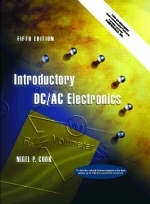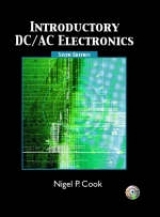
Introductory DC/AC Electronics
Pearson (Verlag)
978-0-13-031085-9 (ISBN)
- Titel erscheint in neuer Auflage
- Artikel merken
For use in DC/AC courses and may also be appropriate for Devices (electronics) courses.
This text covers topics from basic electricity, direct current and alternating current circuits, through semiconductor devices and op amps. It builds upon the highly praised “practical learning approach” with: simulation circuits, circuit analysis tables, protoboard pictorials, historical success stories, guided examples, actual circuit applications, device testing, circuit troubleshooting, performance based objectives, quick-references summary sheets, integrated mini-math sections, and much more, making all of the topics student friendly. This fine-tuned, carefully tested and accuracy checked volume meets the needs of those beginning their training or expanding their career skills in electronics today.
(NOTE: Each chapter begins with an Introduction and concludes with Summary and Review.)Introductory DC/AC Electronics
Introduction to Electronics.
I. THE FUNDAMENTALS OF ELECTRICITY.
1. Voltage and Current.
Mini-Math Review—Exponents and Metric Prefixes. The Structure of Matter. Current. Voltage. Conductors. Insulators. The Open, Closed, and Short Circuit.
2. Resistance and Power.
Mini-Math Review—Algebra, Equations, and Formulas. What Is Resistance? The Ohm. Conductors and Their Resistance. Energy, Work, and Power.
3. Resistors.
Mini-Math Review—Mathematical Operations and Graphs. Resistor Types. How Is Resistance Measured? Resistor Coding. Power Dissipation Due to Resistance. Filament Resistor. Testing Resistors.
II. DIRECT-CURRENT ELECTRONICS.
4. Direct Current (DC).
Source and Load. Direct-Current Sources. Equipment Protection. Switches. Protoboards.
5. Series DC Circuits.
Components in Series. Current in a Series Circuit. Resistance in a Series Circuit. Voltage in a Series Circuit. Power in a Series Circuit. Troubleshooting a Series Circuit.
6. Parallel DC Circuits.
Components in Parallel. Voltage in a Parallel Circuit. Current in a Parallel Circuit. Resistance in a Parallel Circuit. Power in a Parallel Circuit. Troubleshooting a Parallel Circuit.
7. Series-Parallel DC Circuits.
Series- and Parallel-Connected Components. Total Resistance in a Series—Parallel Circuit. Voltage Division in a Series—Parallel Circuit. Branch Currents in a Series—Parallel Circuit. Power in a Series—Parallel Circuit. Five-Step Method for Series—Parallel Circuit Analysis. Series—Parallel Circuit. Troubleshooting Series—Parallel Circuits. Theorems for DC Circuits.
III. ALTERNATING-CURRENT ELECTRONICS.
8. Alternating Current (AC).
Mini-Math Review— Trigonometry. The Difference between DC and AC. Why Alternating Current? AC Wave Shapes. Measuring and Generating AC Signals.
9. Capacitance and Capacitors.
Capacitor Construction. Charging and Discharging a Capacitor. Electrostatics. The Unit of Capacitance. Factors Determining Capacitance. Dielectric Breakdown and Leakage. Capacitors in Combination. Types of Capacitors. Coding of Capacitance Values. Capacitive Time Constant. AC Charge and Discharge. Phase Relationship between Capacitor Current and Voltage.
10. Capacitive Circuits, Testing, and Applications.
Capacitive Reactance. Series RC Circuit. Parallel RC Circuit. Testing Capacitors. Applications of Capacitors.
11. Electromagnetism and Electromagnetic Induction.
Electromagnetism. Electromagnetic Induction.
12. Inductance and Inductors.
Self-Induction. The Inductor. Factors Determining Inductance. Inductors in Combination. Types of Inductors. Inductive Time Constant. Inductive Reactance. Series RL Circuit. Parallel RLCircuit. Testing Inductors. Applications of Inductors.
13. Transformers.
Mutual Inductance. Basic Transformer. Transformer Loading. Coefficient of Coupling. Transformer Ratios and Applications. Windings and Phase. Transformer Types. Transformer Ratings. Testing Transformers. Transformer Losses.
14. Resistive, Inductive, and Capacitive (RLC) Circuits.
Series RLC Circuit. Parallel RLC Circuit. Resonance. Applications of RLC Circuits. Complex Numbers.
IV. SEMICONDUCTOR DEVICES AND CIRCUITS.
15. Semiconductor Principles.
Semiconductor Devices. Semiconductor Materials. Doping Semiconductor Materials. The P-N Junction.
16. Diode and Power Supply Circuits.
The Junction Diode. The Zener Diode. The Light-Emitting Diode. The Transient Suppressor Diode. Diode Power Supply Circuits.
17. Bipolar Junction Transistors (BJTs).
First Approximation Description of a Bipolar Transistor. Second Approximation Description of Bipolar Transistor.
18. Field Effect Transistors (FETs).
Junction Field Effect Transistor (JFET). The Metal Oxide Semiconductor Field Effect Transistor (MOSFET).
19. Operational Amplifiers.
Operational Amplifier Basics. Op-Amp Operation and Characteristics. Additional Op-Amp Circuit Applications.
20. Timers, Thyristors, and Transducers.
Digital Timer and Control Circuits. Thyristors. Transducers.
APPENDIXES.
Appendix A: Electronics Dictionary.
Appendix B: Electronic Schematic Symbols.
Appendix C: Soldering Tools and Techniques.
Appendix D: Safety When Troubleshooting.
Appendix E: Frequency Spectrum.
Appendix F: Answers to Self-Test Evaluation Points.
Appendix G: Answers to Odd-Numbered Problems.
Index.
(NOTE: Each chapter begins with an Introduction and concludes with Summary and Review.)Introductory DC/AC Circuits
Introduction to Electronics.
I. THE FUNDAMENTALS OF ELECTRICITY.
1. Voltage and Current.
Mini-Math Review—Exponents and Metric Prefixes. The Structure of Matter. Current. Voltage. Conductors. Insulators. The Open, Closed, and Short Circuit.
2. Resistance and Power.
Mini-Math Review—Algebra, Equations, and Formulas. What Is Resistance? The Ohm. Conductors and Their Resistance. Energy, Work, and Power.
3. Resistors.
Mini-Math Review—Mathematical Operations and Graphs. Resistor Types. How Is Resistance Measured? Resistor Coding. Power Dissipation Due to Resistance. Filament Resistor. Testing Resistors.
II. DIRECT-CURRENT ELECTRONICS.
4. Direct Current (DC).
Source and Load. Direct-Current Sources. Equipment Protection. Switches. Protoboards.
5. Series DC Circuits.
Components in Series. Current in a Series Circuit. Resistance in a Series Circuit. Voltage in a Series Circuit. Power in a Series Circuit. Troubleshooting a Series Circuit.
6. Parallel DC Circuits.
Components in Parallel. Voltage in a Parallel Circuit. Current in a Parallel Circuit. Resistance in a Parallel Circuit. Power in a Parallel Circuit. Troubleshooting a Parallel Circuit.
7. Series-Parallel DC Circuits.
Series- and Parallel-Connected Components. Total Resistance in a Series—Parallel Circuit. Voltage Division in a Series—Parallel Circuit. Branch Currents in a Series—Parallel Circuit. Power in a Series—Parallel Circuit. Five-Step Method for Series—Parallel Circuit Analysis. Series—Parallel Circuit. Troubleshooting Series—Parallel Circuits. Theorems for DC Circuits.
III. ALTERNATING-CURRENT ELECTRONICS.
8. Alternating Current (AC).
Mini-Math Review— Trigonometry. The Difference between DC and AC. Why Alternating Current? AC Wave Shapes. Measuring and Generating AC Signals.
9. Capacitance and Capacitors.
Capacitor Construction. Charging and Discharging a Capacitor. Electrostatics. The Unit of Capacitance. Factors Determining Capacitance. Dielectric Breakdown and Leakage. Capacitors in Combination. Types of Capacitors. Coding of Capacitance Values. Capacitive Time Constant. AC Charge and Discharge. Phase Relationship between Capacitor Current and Voltage.
10. Capacitive Circuits, Testing, and Applications.
Capacitive Reactance. Series RC Circuit. Parallel RC Circuit. Testing Capacitors. Applications of Capacitors.
11. Electromagnetism and Electromagnetic Induction.
Electromagnetism. Electromagnetic Induction.
12. Inductance and Inductors.
Self-Induction. The Inductor. Factors Determining Inductance. Inductors in Combination. Types of Inductors. Inductive Time Constant. Inductive Reactance. Series RL Circuit. Parallel RLCircuit. Testing Inductors. Applications of Inductors.
13. Transformers.
Mutual Inductance. Basic Transformer. Transformer Loading. Coefficient of Coupling. Transformer Ratios and Applications. Windings and Phase. Transformer Types. Transformer Ratings. Testing Transformers. Transformer Losses.
14. Resistive, Inductive, and Capacitive (RLC) Circuits.
Series RLC Circuit. Parallel RLC Circuit. Resonance. Applications of RLC Circuits. Complex Numbers.
APPENDIXES.
Appendix A: Electronics Dictionary.
Appendix B: Electronic Schematic Symbols.
Appendix C: Soldering Tools and Techniques.
Appendix D: Safety When Troubleshooting.
Appendix E: Frequency Spectrum.
Appendix F: Answers to Self-Test Evaluation Points.
Appendix G: Answers to Odd-Numbered Problems.
Index.
| Erscheint lt. Verlag | 9.5.2001 |
|---|---|
| Sprache | englisch |
| Maße | 218 x 283 mm |
| Gewicht | 2273 g |
| Themenwelt | Technik ► Elektrotechnik / Energietechnik |
| ISBN-10 | 0-13-031085-9 / 0130310859 |
| ISBN-13 | 978-0-13-031085-9 / 9780130310859 |
| Zustand | Neuware |
| Haben Sie eine Frage zum Produkt? |
aus dem Bereich



